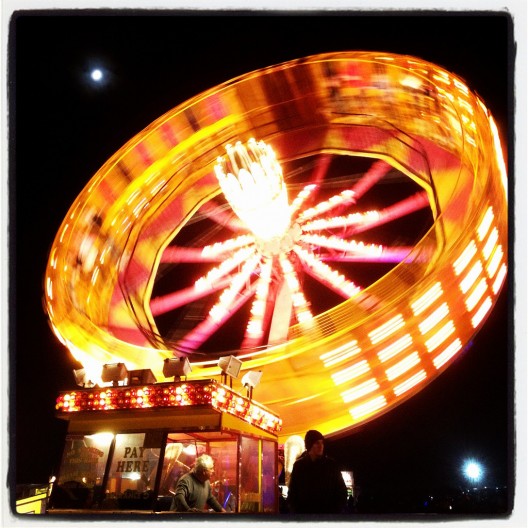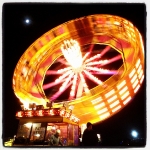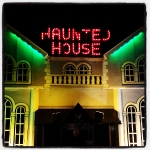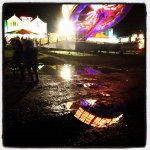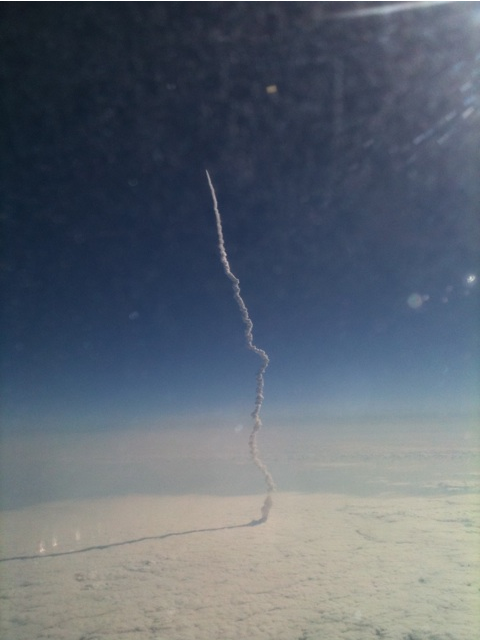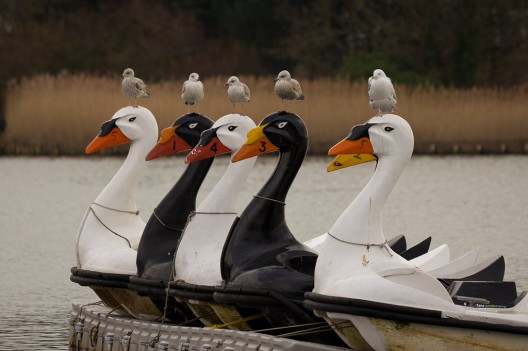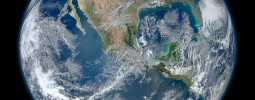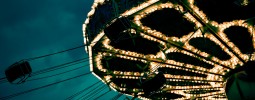So last night we went along to see some fireworks at a local display and the venue we had chosen also had a fun fair with a bunch of rides featuring lots of neon lights and motion. It had been raining quite heavily when we left the house and I hadn’t taken my ‘proper‘ camera with me. So I nonchalantly took out my iPhone 4S and snapped a few impromptu images shortly after we arrived. When I got home I was pleasantly surprised with the result of one of the shots in particular.
I think what is really incredible is that the iPhone camera (and lots of other mobile phones I’m sure) have the potential to capture such decent quality shots in less than ideal conditions. It’s wonderful to have such a capable camera in my pocket with me everywhere I go and from now on I’m going to make a more concerted effort to use it. I think Chase Jarvis may have actually been onto something when he said that The Best Camera is the One That’s with You.
This has really made me reconsider how I think about my iPhone camera in relation to my Canon DSLR. I guess at the end of the day all that matters is making the shot, everything else is kind of irrelevant.
Related Posts:
Silicon Valley start-up Lytro are currently working on a new type of consumer grade camera built using light field sensor technology. I must confess that I previously knew absolutely nothing about light field technology but a quick glance at Wikipedia tells me that it essentially allows (in this case) a camera to capture a photograph with information about the amount of light travelling in every direction through every point in space.
What does this mean to us as photographers? Well according to Lytro one of the main selling points will be that it will allow the photographer as well as users viewing the photograph at a later stage to adjust the focus point. It will also allow images to be displayed in 3D as well as 2D, also as this camera will be more heavily influenced by software rather than hardware it has the potential to allow radical changes when it comes to low light photography and camera/lens design compared to the traditional forms of photography that we all know and love.
Here are a few example shots, including the obligatory cat shot (there are lots more example on Lytro’s website). Click on the image to change the focus point:
You would certainly be forgiven for thinking that this is some kind of elaborate April Fool prank but from what I can gather so far this is in-fact a real camera.
I must admit that I do have some reservations about it at this stage, perhaps from a photographic purity perspective. It sounds like it will allow the photographer to be lazy and simply take a shot then worry about the composition and focus during the post processing, which strikes me as a negative thing. I guess we will have to wait and see but putting my fears for the craft aside I am always excited by new gadgets and developments in the industry and I can’t wait to get my hands on one to try it out for myself.
Related Posts:
Twitter always seems to be on top of the latest news stories and has made a number of internet celebrities along the way. Most notably perhaps Janis Krums’ photo of the U.S. plane that crash landed in New York’s Hudson River in January 2009.
Yesterday another internet celebrity was born as Nasa launched the space shuttle Endeavour for the very last time and Stefanie Gordon happened to be descending on her flight from New York to Palm Beach. Using her iPhone she was able to catch the following shot which subsequently went viral:
Mashable have the full story but here is a brief extract:
When Stefanie Gordon boarded her plane in New York City to visit her parents in Palm Beach, the captain noted there was a chance passengers would witness the space shuttle Endeavour’s last launch during the flight. But she never expected to play a role in documenting it.
As the plane descended toward Palm Beach and the Endeavour’s launch became visible, Gordon pulled out her iPhone and snapped a few photos and a short video. On the ground, she posted one of the photos to her then 1,800 Twitter followers.
In a few hours, she was fielding phone calls from ABC, the BBC and CNBC. She had accumulated about 1,000 new Twitter followers, and she had to turn the @mention push notifications off on her phone so they wouldn’t drain the battery.
from: mashable.com/2011/05/16/endeavour-launch-twitpic/
What an incredible shot and it just goes to show the possibilities that are offered by combining a smartphone with social media and a spot of good fortune!
Happy shooting!
Related Posts:
A couple of months ago I wrote a blog post about the recently discovered but sadly deceased street photographer Vivian Maier (1926-2009). Vivian Maier spent most of her life working as a nanny but spent almost 40 years beginning in the 1950s photographing Chicago during her free time. Her huge body of work was never displayed and was unknown until being discovered after her death. You can read a little more about her here.
Well it turns out that another wonderful street photographer has recently been discovered after his death and from what we know so far this is an equally fascinating story. According to the information available on The Perfect Exposure Gallery website (who are currently exhibiting some of the work) Frank Oscar Larson (1896-1964) lived and worked in Queens NTC in the 1950s and was passionate about street photography. Like Vivian Maier he spent much of his free time wandering around the city with his Rolleiflex camera taking shots of anything that caught his eye, visiting locations such as Chinatown, Hell’s Kitchen, Times Square & Central Park. Frank developed and printed his own film but much of the work was never seen by anyone other than him. Sadly Larson died in 1968 and his work would remain undiscovered until a box of negatives would be discovered some 45 years later.
I have to say that I find this work absolutely fascinating. There is something incredibly compelling about images taken from a completely different era, especially candid shots like this rather than the iconic celebrity and landscape shots we are more used to seeing.
Here are a few examples of his work (more of the work can be seen by following the links below):
All images © Frank Oscar Larson
An exhibition entitled “Reflections of New York” featuring the work of Frank Oscar Larson has just ended at the Perfect Exposure Gallery in LA. The information is still available on the gallery website as well as lots more examples of his work. I would urge you to take a look while it is still available.
Frank Oscar Larson’s website
http://www.franklarsonphotos.com/
Information about the “Reflections of New York” exhibition
http://www.theperfectexposuregallery.com/
Examples of Frank Oscar Larson’s work
http://www.theperfectexposuregallery.com/admin/guide.php?proj=12
Happy shooting!
Related Posts:
I recently decided that it might be fun to make a pinhole camera, as a little experiment. Having never made one before I decided that I would make a matchbox pinhole camera, as described on the following site:
http://www.matchboxpinhole.com/
So I carefully assembled the various pieces, which were all very inexpensive, in-fact the most expensive item was the roll of 35mm film, which was £4.99.
The items I needed were as follows:
* A matchbox;
* Roll of 35mm film;
* An empty roll of 35mm film with at least 1cm of film sticking out;
* Some thin cardboard;
* Empty can of coke;
* Black electrical tape;
* A plastic spiral binder;
* A thin sewing needle/pin;
* Scissors;
* Craft knife;
* Black marker pen;
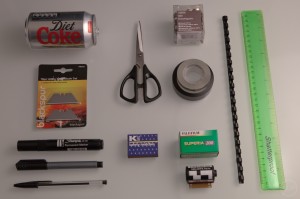
Pinhole camera ingredients
I would estimate that following the very simple instructions available on http://www.matchboxpinhole.com/ it only took me about 30 minutes or so to assemble (in my mind’s eye I resembled MacGyver, creating something incredible from next to nothing). It was all very painless and in no time at all I had created my very own, tiny, pinhole camera.
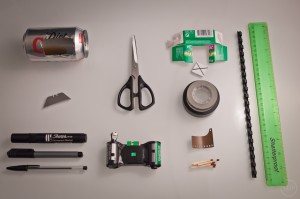
Pinhole camera complete
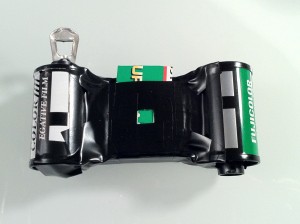
Matchbox Pinhole Camera
Now armed with my newly assembled camera I was keen to take some photos, but sadly by this point it was getting rather late in the day and perhaps more importantly, rather dark. So I reluctantly decided that I would have to wait until the following day before capturing my prize winning shots!
Sadly the world had other plans for me and for the next two days I didn’t get an opportunity to get out and about with my camera during daylight hours. So I decided that on the weekend I would be out with my pinhole camera come wind, rain or shine.
As it turned out the weekend was absolutely lovely, so I set off with my DSLR camera and my pinhole camera in an effort to find something worthy of the use my 35mm film. Shooting on film is something I haven’t done for a long time and it was a rather unique feeling to actually have to stop and consider the 24 shots I had available. As I typically shoot digital I am free from the shackles of film, but in a way, knowing that you only have a finite number of shots and that the moments would perhaps have to be picked somewhat more carefully than normal was actually quite refreshing.
I had read the instructions on the matchboxpinhole.com website and understood that exposure when outside should be somewhere between 1-2 seconds and that it was best to take at least three shots of each subject at varying exposure lengths, in an effort to try and ensure a useable shot. As it turns out, this is extremely good advice!
So with the above information in mind, taking three shots for each subject would leave me with approximately eight actual shots to take. I headed to the beach and set about taking a number of shots, at one point I felt sure I had broken the camera but I continued on anyway, just in case. Another problem was that I was using a ring pull to wind the film into the empty canister and after only a couple of photos the plastic lugs started to break, which made the winding rather difficult. I persevered and after taking a few shots at the beach I headed to the forest to capture a few final photographs.
Once I had finished the roll of film I wound the film back into the correct film canister and looked forward to seeing how my shots would turn out. This was Saturday evening, so I would now have to wait until Monday at the very earliest before I could get my film developed. I did consider developing the film myself, but decided that by the time I had bought all of the chemicals I would have spent a reasonable amount of money and would still have to wait for the items to arrive by post. I decided I would get this film developed and look to process the next film myself.
On Monday morning I took the film to a local one hour processing facility, making sure to let the person behind the counter know than the film was shot on a pinhole and that the spacing of the shots may be irregular. She was very helpful and told me she would be super careful. I now had to wait patiently for an hour in order to see how good (or more likely, rubbish) my photos were going to be. One of the problems with the basic pinhole I had created was that it did not have a viewfinder, so it was rather difficult to work with composition. It was really just a case of pointing it in roughly the direction I wanted to capture and hoping for the best. My next pinhole camera will certainly need to have a viewfinder built into it!
Well one hour later I got my shots and feverishly unwrapped them to discover that they were in fact… rather terrible. They were mostly overexposed and the composition was not great. One of the biggest problems for me was judging the distance I needed to be from my subject. It turns out that I need to be much closer to the subject than I had imagined and I also needed to expose the shot for closer to a second and no longer. Well, it’s fair to say I was disappointed with my shots but I won’t be deterred. I’m going to make another pinhole camera, but this one will be more sophisticated (i.e. with a viewfinder) and being armed with the experience of the first camera I may even get a half decent shot!
Oh and here are a couple of the shots from my first pinhole camera attempt.
Making a pinhole camera is cheap, very easy and lots of fun. It can make you think about your photography in new ways, especially if you are used to shooting with digital. It’s well worth having a go and who knows, unlike me, you may even get some great shots on your first attempt!
Happy shooting!
Related Posts:
Just a very quick post to share a photo I took while driving home this afternoon.
I spotted these seagulls resting on the heads of some floating swan rides and immediately had to stop the car to get the shot. A random passer by looked at me with my camera and then looked out to where my lens was pointing and remarked “That’s really funny, I just wish I’d brought my camera out today”.
So it just goes to show that it’s always worth having a camera handy if possible to capture those quirky unexpected moments.
Have a great weekend!
